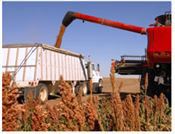|
Harvesting Quality Grain Sorghum

DR. BRENT BEAN
KANSAS CITY, MO.
Harvesting quality grain sorghum begins with timely harvest. Ideally, grain sorghum should be harvested when the moisture content is between 17 and 20 percent. Elevators and end users differ on when they begin discounting for moisture, but any grain above 14 percent can be subject to a charge. In some regions, extended periods of wet weather can lead to lodging, grain deterioration from molds and seed sprouting. For this reason, growers are encouraged to harvest as soon as the crop reaches maturity.
If all grain heads in the field reach maturity at the same time and the heads extend above the flag leaf, growers may avoid the use of a harvest aid (desiccant) or the need of a hard freeze to kill and desiccate the plants. However, most of the time, growers still need a harvest aid to eliminate late green tillers, weeds and sorghum leaves that interfere with timely harvest.
The most common harvest aid in grain sorghum is glyphosate. The key to successfully using glyphosate is to treat only the amount of acres that can be harvested in a timely manner. Growers should try to harvest glyphosate-treated sorghum eight to 15 days after application. If harvest is delayed, the sorghum is at risk of lodging. Also, the addition of Aim herbicide with glyphosate can aid in the control of morning glory and other tough-to-control weeds. A full discussion on the use of a harvest aid is available at www.sorghumcheckoff.com in the Agronomy Library.

Once harvest begins, growers should cut just below the heads to avoid unnecessary intake of leaves and stalk material, which decreases harvesting efficiency. Grain sorghum can be harvested with a grain header (platform or rigid cutter bar), flex header, row crop header or draper header. When using a grain header, guard extensions attached to every other guard will reduce gathering losses in standing sorghum. Other attachments are available that can help with lodged sorghum if needed.
Recently, a company developed a conversion kit for corn headers called ARROTM (Alternative Rotary Rowcrop Option), with kits available for most all corn header brands. These kits have worked well, and growers are using them in increasing numbers in the sorghum belt.
Finally, growers should take their time when setting their combines because a well-adjusted combine can add a significant amount of income per acre. Loss is determined by counting seeds left behind the combine. Depending on seed size, 16 to 21 seeds per square foot will equal one bushel per acre. A 5 percent loss is considered acceptable for grain sorghum. ∆
BRENT BEAN, Ph.D.: Sorghum Checkoff Agronomist
|
|